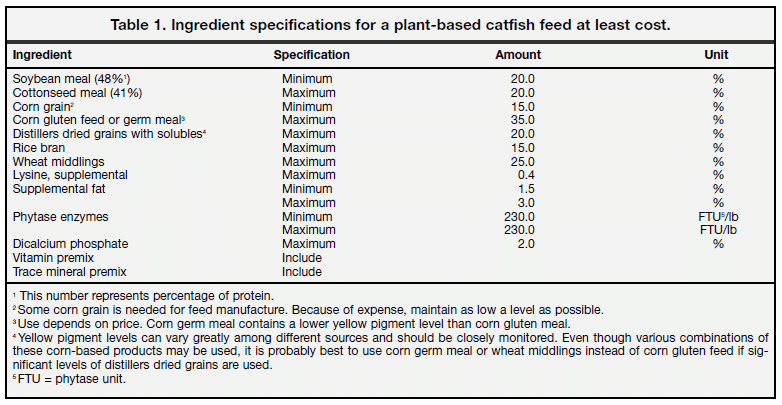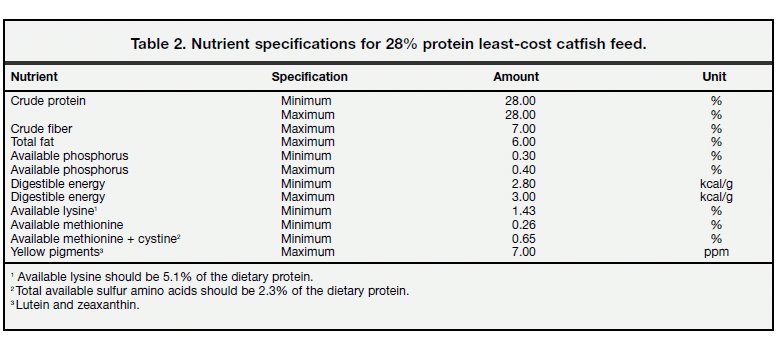Historically, commercial catfish feeds have contained fishmeal or other animal protein sources because these products were generally considered to be necessary to provide essential nutrients and to improve feed palatability. However, numerous research reports have shown that catfish grown from stocker to market size do not necessarily require animal protein. Over the last several years, we conducted a variety of studies comparing plant and animal protein sources in catfish feed. Treatment means averaged from weight gain (pound per fish) and feed conversion ratio were almost identical in these studies, regardless of whether plant or animal sources were used. For fish fed plant-based diets, weight gain was 1 pound per fish and feed conversion ratio was 1.65. Compare these averages to fish fed feeds containing animal feedstuffs: weight gain of 1.04 pound and feed conversion ratio of 1.60. Other researchers have reported similar results, and plantbased feeds have been used successfully in commercial catfish culture for years. Even so, some catfish producers still insisted that animal protein be included in commercial catfish feeds—that is, until the price of these products rose to a level basically prohibiting their use. Currently, animal protein is used sparingly in feeds for catfish fry and small fingerlings, but most commercial catfish feeds used for grow out are plant-based.
FEEDSTUFFS
Plant-based feedstuffs commonly used in catfish feeds include soybean meal, cottonseed meal, corn grain, corn gluten feed, corn germ meal, distillers dried grains with solubles, wheat middlings, and rice bran. Feedstuffs such as canola meal, peanut meal, sunflower meal, and others could be used, but they are generally not available at a reasonable cost in the primary catfish growing areas. Aside from soybean meal, other plant feedstuffs are typically deficient in lysine, but using supplemental lysine can compensate for this. Some plant proteins contain toxins and antinutritional factors, but these are typically not a problem because they are either present in very low concentrations or are inactivated during processing or during feed manufacturing.
Soybean meal has traditionally been the predominant feedstuff used in catfish feeds because it is high in protein (48%), has the best amino acid profile of all common plant feedstuffs, and is highly palatable and digestible to catfish. The inclusion rate for soybean meal in catfish feeds has been 40–50% of the feed. However, because of the dramatic increase in soybean meal prices in recent years, other feedstuffs are being used to replace as much soybean meal as possible without affecting fish performance. Cottonseed meal or a combination of cottonseed meal and corn gluten feed, corn germ meal, or distillers dried grains with solubles plus supplemental lysine can be used in place of soybean meal. Though some studies indicate soybean meal can be completely replaced, data from more recent studies suggest that probably no more than about 50% of the soybean meal should be replaced in catfish feeds based solely on plant feedstuffs. Higher levels may reduce processed yield likely due to the lower protein digestibility, imbalanced amino acid composition, and high fiber content. Another consideration is product quality. For example, all corn-based feedstuffs contain yellow pigments that if fed in high enough concentrations can result in a discoloration of edible tissue that is unacceptable to the consumer. Distillers dried grains with solubles contain a relatively high amount of yellow pigment, thus its use may be limited more by this problem than nutritional quality. We recommend that the feed contain no more than about 7 parts per million of yellow pigment. At least 15–20% corn grain is generally needed to achieve proper expansion of feed pellets during extrusion, which allows the feed to float. Therefore, the use of other corn-based feedstuffs (particularly distillers dried grains with solubles) is limited. Feedstuffs such as wheat grain, wheat middlings, and rice bran may be used but are not currently widely used.
FORMULATING PLANT-BASED FEEDS
When nutritionists use least-cost computer programs to formulate catfish feeds, the goal is to make the least expensive product possible given a specific set of criteria that ensure the feed is of the quality needed for catfish. In other words, a properly balanced feed should meet the nutritional and energy requirements of an animal in a palatable and digestible form. Regardless of the specifications used, it is essential to check the formula to ensure that ingredient composition is practical and nutritional requirements are met. Once a basic formula is established, typically only minor adjustments are needed to get a practical formula that meets the set criteria. The ingredient specifications in Table 1 should be used as a guideline because actual amounts of feedstuffs used may vary somewhat due to differences in nutrient content or product quality. Nutrient specifications given in Table 2 are for a 28% protein feed, which we recommend for catfish. Numerous studies have shown that 28% protein provides the same growth as 32% protein. Over the last 15 years or so, we conducted many studies comparing these protein concentrations. Means averaged from these studies show that weight gain and feed conversion ratios were similar for 28% and 32% protein feed. Weight gain (pounds per fish) and feed conversion ratio were 1.13 and 1.67, respectively, for fish fed a 32% protein feed; 1.18 and 1.65, respectively, for fish fed 28% protein.
SUMMARY
Considerable research has been conducted over the last two decades on plant-based catfish feeds, including the evaluation of plant-based feeds containing various protein levels. The data show that a feed prepared from feedstuffs of plant origin containing 28% protein is adequate for rapid catfish growth from stocker to market size. We recommend that no more than about onehalf of the soybean meal be replaced with alternative feedstuffs. In addition, when you use corn-based byproducts to replace part of the corn grain and/or soybean meal, we recommend that yellow pigments not
exceed 7 parts per million. The information presented in Tables 1 and 2 is based on the best information we have, but it should be considered as a guideline and therefore is subject to change.
July 2014





